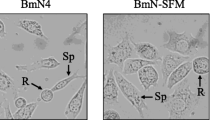Abstract
We have established a novel cell line from a Vero cell derivative that is useful for expression of exogenous genes and protein production. Parental Vero-317 cells can grow in biotin-containing Eagle's MEM without supplements. By transforming this cell line with replication origin-defective SV40 DNA, which contains a temperature-sensitive tsA58 large T antigen gene, we established the Verots S3 cell line that amplified a SV40-origin containing plasmid. The cell line expressed a human growth hormone (hGH) gene insert with higher efficiency than COS-7 cells in 5% serum-containing MEM and could grow and continue hGH expression in protein-free MEM. However, temperature-sensitive shut down of hGH production was observed not immediately but 3 days after the temperature shift from 33°C to 39.5°C.
Similar content being viewed by others
References
Buckley SM & Casals J (1970) Lassa fever, a new virus disease of man from West Africa. III. Isolation and characterization of the virus. Am. J. Trop. Med. Hyg. 19: 680–691.
Gluzman Y (ed.) (1982) Eukaryotic viral vectors. Cold Spring Harbor Laboratory, Cold Spring Harbor, New York.
Kern FG & Basilico C (1986) An inducible eukaryotic host-vector expression system: amplification of genes under the control of the polyoma late promoter in a cell line producing a thermolabile large T antigen. Gene 43: 237–245.
McCormick JB, Sasso DR, Palmer EL & Kiley HP (1982) Morphological identification of the agent of Korean haemorrhagic fever (Hantaan virus) as a member of the bunyaviridae. Lancet April 3: 765–768.
Mosca JD & Pitha PM (1986) Transcriptional and post-transcriptional regulation of exogenous human beta interferon gene in simian cells defective in interferon synthesis. Mol. Cell. Biol. 6: 2279–2283.
Portela A, Melero JA, de la Luna S & Ortin J (1986) Construction of cell lines and expression of influenza virus nonstructural protein genes. EMBO J. 5: 2387–2392.
Rhim JS, Schell K, Creasy B & Case W (1969) Biological characteristics and viral susceptibility of an African green monkey kidney cell line (Vero) (34285). Proc. Soc. Exp. Biol. Med. 132: 670–678.
Rio DC, Clark SG & Tjian R (1985) A mammalian host-vector system that regulates expression and amplification of transfected genes by temperature induction. Science 227: 23–28.
Sambrook J, Fritsch EF & Maniates T (eds.) (1989) Molecular Cloning. A Laboratory Manual. Second Edition, pp. 1.25–1.28.
Seldin R, Howie KB, Rowe ME, Goodman HM & Moore D (1986) Human growth hormone as a reporter gene in regulation studies employing transient gene expression. Mol. Cell. Biol. 6: 3173–3179.
Shilo B & Weinberg RA (1981) DNA sequences homologous to vertebrate oncogenes are conserved in Drosophila melanogaster. Proc. Natl. Acad. Sci. U.S.A. 78: 6789–6792.
Sidvey JM (1988) New genetic methods for mammalian cells. Bio/Technology 6: 1192–1196.
Simizu B & Terasima T (eds.) (1988) Vero cells — Origin, properties and biomedical applications. Department of Microbiology, School of Medicine Chiba University, Chiba University, Chiba.
Yasumura Y, Niwa A & Yamamoto K (1978) Phenotypic requirement for glutamine of kidney cells and for glutamine and arginine of liver cells in culture. In: Katsuta H (ed.) Nutritional Requirements of Cultured Cells. Japan Scientific Societies Press, Tokyo, and University Press, Baltimore, pp. 223–255.
Author information
Authors and Affiliations
Rights and permissions
About this article
Cite this article
Ohno, T., Wang, X., Kurashima, J. et al. A novel Vero cell line for use as a mammalian host-vector system in serum-free medium. Cytotechnology 7, 165–172 (1991). https://doi.org/10.1007/BF00365927
Received:
Accepted:
Issue Date:
DOI: https://doi.org/10.1007/BF00365927




